Campaign History of the 151e Régiment d'Infanterie - XXII
~ 1917 ~
The Crisis of Morale (5-30 May) and Return from the Brink (1 June - 14 July)
5-31 May: The 5 May is spent washing up and cleaning uniforms, equipment and weapons. The companies and battalions are also reorganized. The next day, General Passaga (commanding 32e Corps d'Armée) reviews the regiment at 1500 hrs south of Bouvaucourt. On 7 May the 151 marches to Villers-Agron where it will remain billeted for a couple weeks. Bordinat once again recounts for us:
On Monday 7 May, we receive official orders to pull back further to the rear to the great joy of all. After having marched all day, we arrive at Villers-Agron [southwest of Reims], in a camp made up of Driant style barracks at least thirty kilometers from the firing line. We recover a little bit of life after holding on for so long by a thread, and under the radiant sunshine, one forgets once more the sad days spent in turmoil. While here, we receive as reinforcement from the 351st Reserve [Infantry Regiment, their former sister regiment], coming from Belgium to make up our losses.Other notable information from this period follows below. But first we will pause a moment here and allow Bordinat to provide us with a window into the the situation on the ground. His account is provided here in full.
After a fortnight spent in this country, we are ordered to go up to the line. This causes pretty much a general discontent, caused by all manners of injustice. This unfortunate attack on the Aisne on 16 April 1917 had a repercussion in the army as well as in the Interior, as the men on furlough recount that there were accusations made of treason. Many units mutinied, refusing categorically to return to the line until they had leave. The regulation time had long elapsed owing to the fact every time there was an offensive in anyway, the fighting troops this great moral comfort under the pretext that it would hinder the operations.Beginning 9 May, training is resume with principal exercise in the morning and specialist instruction in the afternoon. This training will continue for the next several weeks. Lieuts. Mulotte and Teyssier are promoted definitively to the rank of capitaine. The next day, Lieut. Parmentier is breveted to capitaine. On 10 May Capt. de Sainte Croix, Lieuts. Canredon, Couduzorgues and de Mondion return to the regiment after being previously evacutated. Capt. Lotte coming from the 272 RI takes command of 1 MG Co. on 16 May. Capt. Dutilloy coming from the 148 RI is assigned to the DD. Sous-Lieut. Lecomte is breveted to lieutenant on 17 May. Sous-Lieut. Dievart, Meunier, and Cartier are promoted definitively to that rank on 18 May. Sous-Lieut. Adam and Erkens are breveted to the rank of lieutenant on 19 May. Aspirant Froissard, Lecerf, Gund, and Adjudants Vermeulen, Le Ridant are all breveted to the rank of sous-lieutenant.Also, it was with valid justification, since there were all the boys in the rear service who were able to see their families without being forced to endure all the myriad hardships as we did. And all these shirkers [embusqués], as they were called, treated us like we were fools. Finally exasperated after so many slaps in the face, we made it known plain to our commanders the constantly increasing dangers we were exposed to and fed up with], and that they should as quickly as possible raise these with the right authorities, inviting them to finally take these grievances into consideration, to improve our lot as best as could be done.
Since 1915 for example, it was sickening to see lots of young people employed in the rear services, strutting around leisurely for months or even a year in a village or town, sheltered from all the dangers and miseries...It was not not uncommon to see people already wounded several times, go back to field of honor to get killed, while workers fresh and available, full of health and wanting of nothing (including arrogance), lived peaceful lives, more often than not, not knowing what to do with themselves.
And it was the same thing with the officers: the officer of the trenches was a zero compared to that of the rear. It was because of all these shameful injustices that the poilus sang of their mental and physical suffering in front of our very commanders, who well often did not encourage us, as was their duty not to. Nonetheless, the officers couldn't help but be all ears, constantly warning [their superiors] of the ever-increasing danger. I still remember some inflamed couplets, these songs which were composed by people who had done a turn of front in the years 1916-1917, as well as the some stanzas composed in the trenches during days of despair.
Outside the country, the situation was hardly more encouraging. The Russian Revolution that followed their shameful peace treaty, as well as the misfortune of Romania being crushed on all fronts, we knew all too well that we would we would soon have a backlash along either the Anglo-French front or the Italian one. We also had had the Boche peace proposal at the time made in the first days of the year 1917. Since our last failure, there was little hope ventured in an advantageous outcome for our side.
I think that if you had asked for a vote for the continuation of the war from the combatants, there would have been a good chance of a "no" vote at this time. Only one hope remained for us upon seeing the official declaration of America's entry into the war. But how would these Americans arrive here, with submarines? After what's happened to England around this time, there's no way the American army could get a million men to our shores in a year.
In short, we would have to overcome all these difficulties on our own. Our situation began to improve. A half-liter of wine [a day] was now distributed to us, the number of cooperatives were increased up to the trenches, where it was easier for us to acquire things that were more practical to our needs. Additionally we began to receive a combat allowance, fixed at three francs, half of which was paid out with the other half going to a pension. It was also arranged that we would get a ten-day furlough at least three times a year and what's more, canteens were established in the train stations where you could find a free meal in certain locations along with a number of small things useful to our well-being.
We were also informed that units would not be constantly left in the line at the detriment to another and that they would replace older fathers with families with the younger people from the unnecessary rear services. Likewise, in the war factories, the shirkers were chased out, a task that wasn't all that easy according to the people charged with this job. In each company, they created a report of the men's morale, which examined with care all our complaints. These were often satisfied, so that little by little calm was restored. You felt that really there was a little more respect given to the combatant and everyone felt less like cannon fodder and more human. Wasn't that fair afterall?
Until the end [of the war], our lot continued improve, even if it meant the rear-line people were often made to come join us in the line...So it's under these conditions that at 4 am on 30 May, on the eve of getting ready to return to the line, to our great astonishment we took the road in the opposite direction. Nothing could cheer us more than this lovely surprise.
Lieut. Thiébaud returns on 21 May after being previously wounded and evacuated to retake command of 2 MG Co. Meanwhile, on 22 May a detachment of reinforcements coming from the Divisional Depot arrives composed of 4 adjudants-chefs, 6 aspirants, 7 sergents, 1 sergent-fourrier, 18 caporaux, and 122 soldiers. The nexy day, Capts. Garavel, Moracchini, Lieut. Maillard, Sous-Lieuts. Mittens and Boyer, and Médecin-aide-major Lhounure [sp?] arrive from the 351 RI. On 23 May, Capt. Bertrais, previously wounded and evacuated, returns to the regiment. Meanwhile, the 5 Battalion of the 351 RI arrives in whole as reinforcement, comprised of 1 adjudant, 8 sergents, 56 caporaux, 3 caporaux-fourriers, 1 maréchal des logis and 512 soldiers.
On the afternoon of 25 May, General Passaga (commanding 32e CA) reviews the regiment between Vézilly and Goussancourt. Adjudant Girot is promoted to sous-lieutenant. The next day the 151 marches to Beuvardes to billet where they will remain until 30 May. On 26 May, the 151 moves to Beuvardes where the regiment sets up in its billets. On 27 May, Médecin Aide Major Minkowsky is transferred to the Ambulance 15/17. On 31 May, the regiments marches off to new billets at Barzy-sur-Marne, Rozny, Passy (Marne). Sous-Lieut. Baillat (previously evacuated) returns to the regiment and is made porte-drapeau, replacing Lieut. Courreaux who becomes Assistant to the Colonel.
1-17 June: Sous-Lieut. Hugon, coming from the Divisional Depot, is assigned to 1 MG Co., and on 13 June, Sous-Lieut. Diévart returns from evacuation and is assigned to the 3 Co. Over the course of 3-14 June, the regiment marches to successively billets in a torrid heat, first to Chierry and Blesmes, then Pargny-la-Dhuys, Montigny and Montlevon, then Bergères, Courbeteaux and Machaunay, then Courgeonnet, Villevenard en Talus St. Prix, then Fère-Champenoise and Suvy, then Mailly-Village (Mailly-le-Camp, Aube). Finally, on 15 June, the entire regiment marches to where it will be definitively posted, to an area south of Camp de Mailly. The regimental staff, CHR, and 3 Bat. will billet at Ramerupt, the 2 Bat. at Romaines, and the 3 Bat. at Vaucogne (Aube).
Photo taken by Aspirant André L'Huillier on 13 June 1917 outside of Villevenard. His original caption notes that several men had already gone down with heatstroke.
18-25 June: The 151 begins a two-week period of instruction and training at Camp de Mailly to improve upon their previous combined-arms and fire-and-movement training. Aside from this immediate goal though was the underlying objective of re-instilling an esprit de corps. The daily program established by Colonel Moisson is as follows:
0430 hrs - Reveille (0630 hrs on rest days)
0515 to 0930 hrs - Exercises
1000 hrs - Soup
1100 to 1400 hrs - Rest (siesta)
1430 hrs - Daily morale formation of companies
1500 to 1700 hrs - Specialist exercises
1730 hrs - Soup
1830 to 1930 hrs - Evening concert
2020 hrs - Roll call
2100 hrs - Lights out
On 18 June, a detachment of reinforcements arrives from the Divisional Depot composed of 3 sergents, 2 caporaux, and 179 men. Beginning on 21 June, the training shifts to focusing on specialist instruction, principally for fusil-mitrailleuses (automatic-rifle) and grenadiers. On 23-24 June, battalion-level maneuvers are carried out, including working in coordination with airplanes. On 24 June regiment-level maneuvers are carried out, with the taking of four successive enemy positions.
26-27 June: The day is dedicated to a Regimental Party. There is a prise d'armes at 0800 hrs in the Parc du Château de Romaines. Sous-Lieut. Raymond Jubert is awarded the Médaille Militaire and Sous-Lieut. Spaenlé receives the Croix de Chevalier de la Légion d'Honneur. Following its citation for its actions in the Nivelle Offensive, the 151 had earned its fourth battle honor (and fourth Croix de Guerre) to be inscribed on the regimental colors: L’Aisne. Colonel Moisson announces that the regiment has been awarded the right to wear the fourragère of the Croix de Guerre. As a unit-distinction, this entitled all men serving in the regiment to wear the distinction. At the time, it was only the eleventh infantry unit to have received this distinction. Following mass, the rest of the day is spent at rest in social gatherings, games and recreational distractions. At 2130 hrs, the regiment returns to Ramerupt bearing torches. The next day is spent at rest.
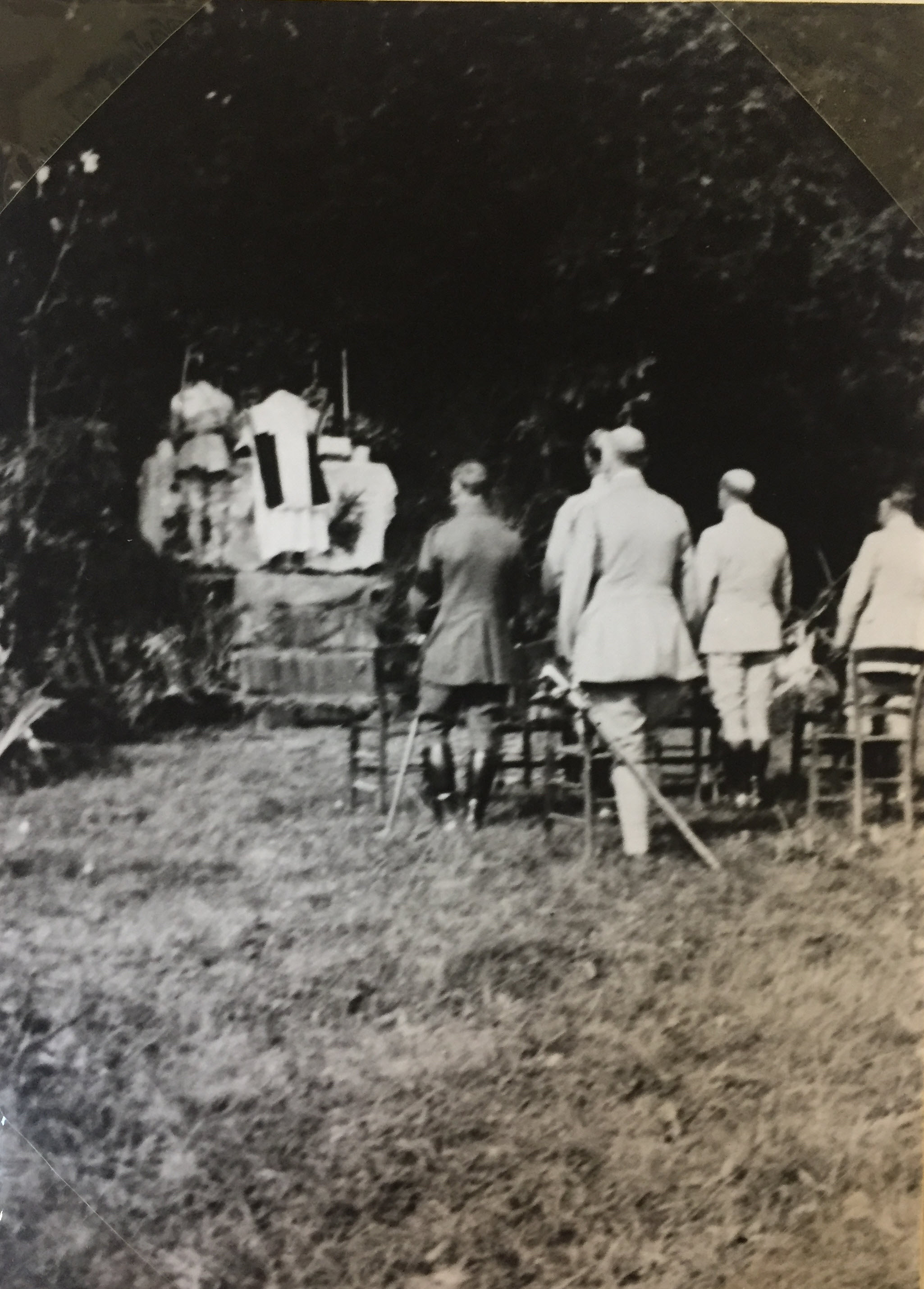
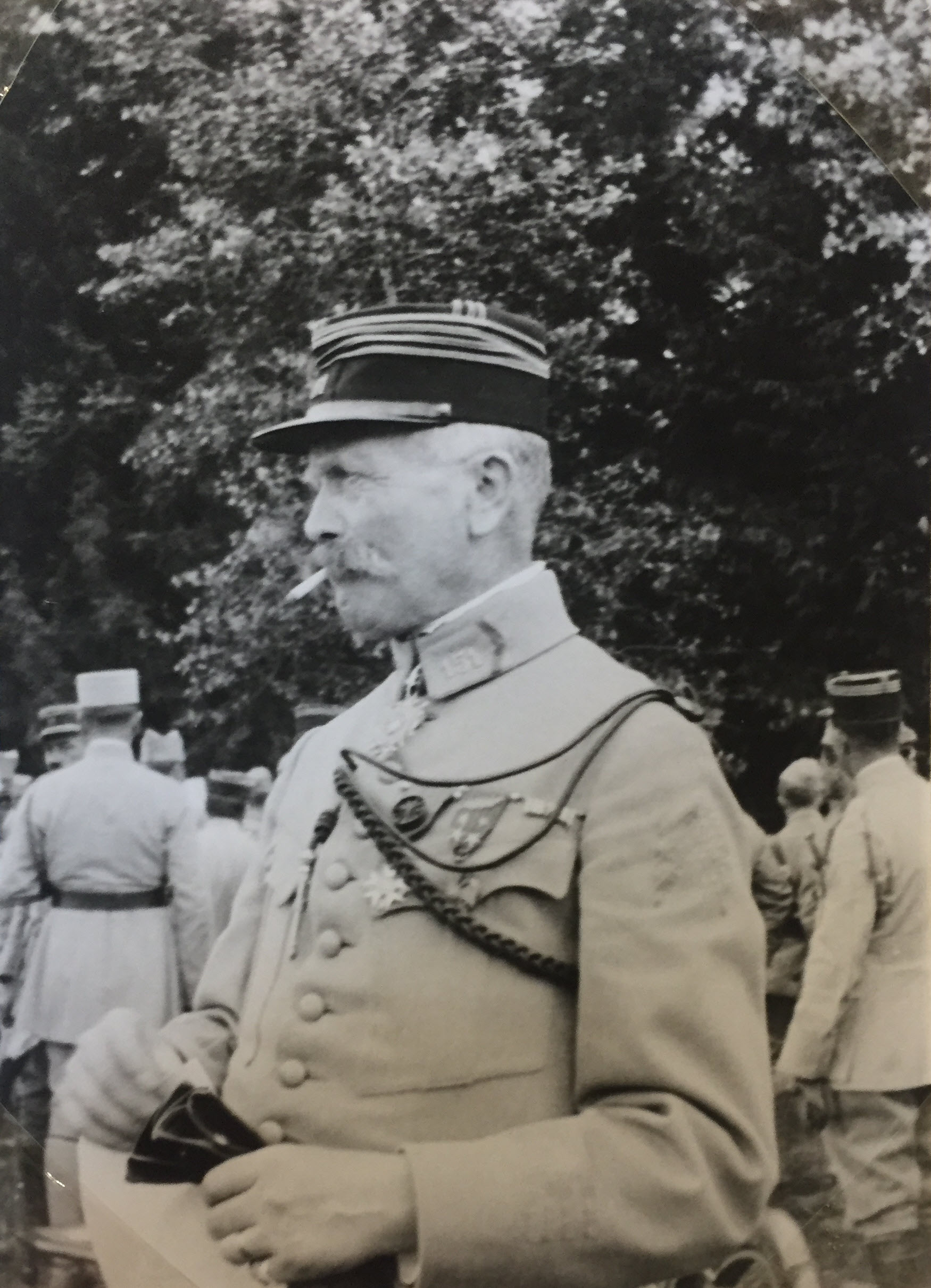
Photos taken by Aspirant André L'Huillier on 26 June 1917. From left to right: Mass being held by regimental chaplain Henocque; Commandant Marc Arthur Oblet (2 Battalion commander); Colonel Moisson and General Monroe sitting with two costumed soldiers (the mayor and his wife).
Photos taken by Aspirant André L'Huillier on 26 June 1917. From left to right: A sack race; costumed soldiers who presumably were putting on a vaudevillian-style performance.
28 June: At 0800 hrs, the entire 69 Division is reviewed by General Fayolle (army commander), General Passaga (32 CA commander), and General Monroe (69 DI commander) at Camp de Mailly. General Fayolle decorates the regimental colors with the fourragère of the Croix de Guerre. Fayolle also decorates the fanion of the 3 MG Co. (commanding by Capt. Gelly) for its citation in the Orders of the Army Corps for is good conduct at Choléra and the fanion of the 11 Co. (commanded by Capt. Wébanck) for its citations in the Orders of the Army and the Orders of the Army for its good conduct at Mort Homme and Choléra, respectively. After the review, the regiment goes to eat breakfast at the Ferme Valmont, returning to its billets at 1600 hrs.

Photo taken by Aspirant André L'Huillier on 28 June 1917. Left: the color-guard for the Croix de Guerre ceremony, with Aspirant L’Huillier stands on the left and Lieut. Donsimoni at center with colors. Right: six poilus of the 151 decorated with the Croix de Guerre with Lieut. Donsimoni standing at right with colors.
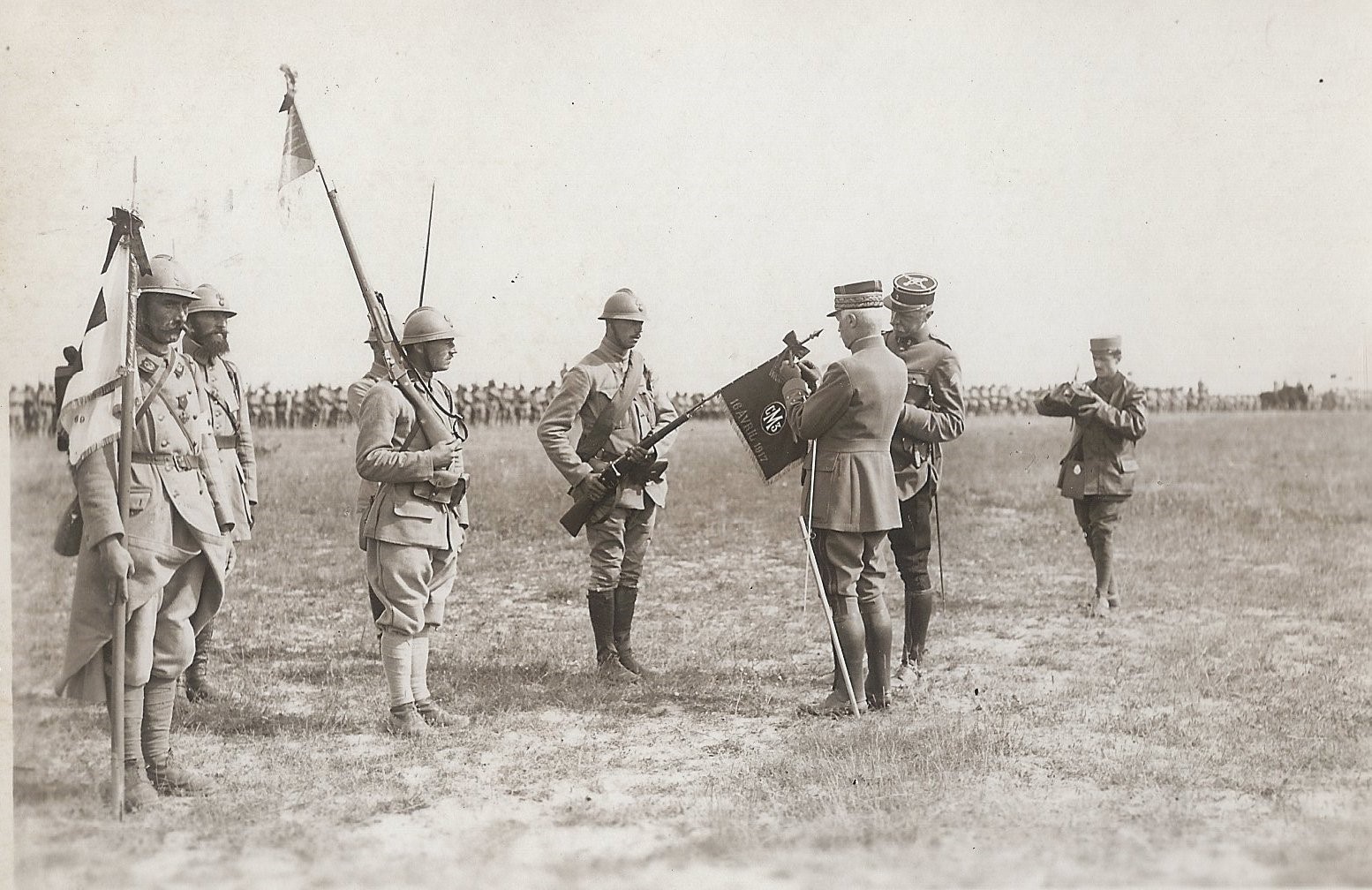
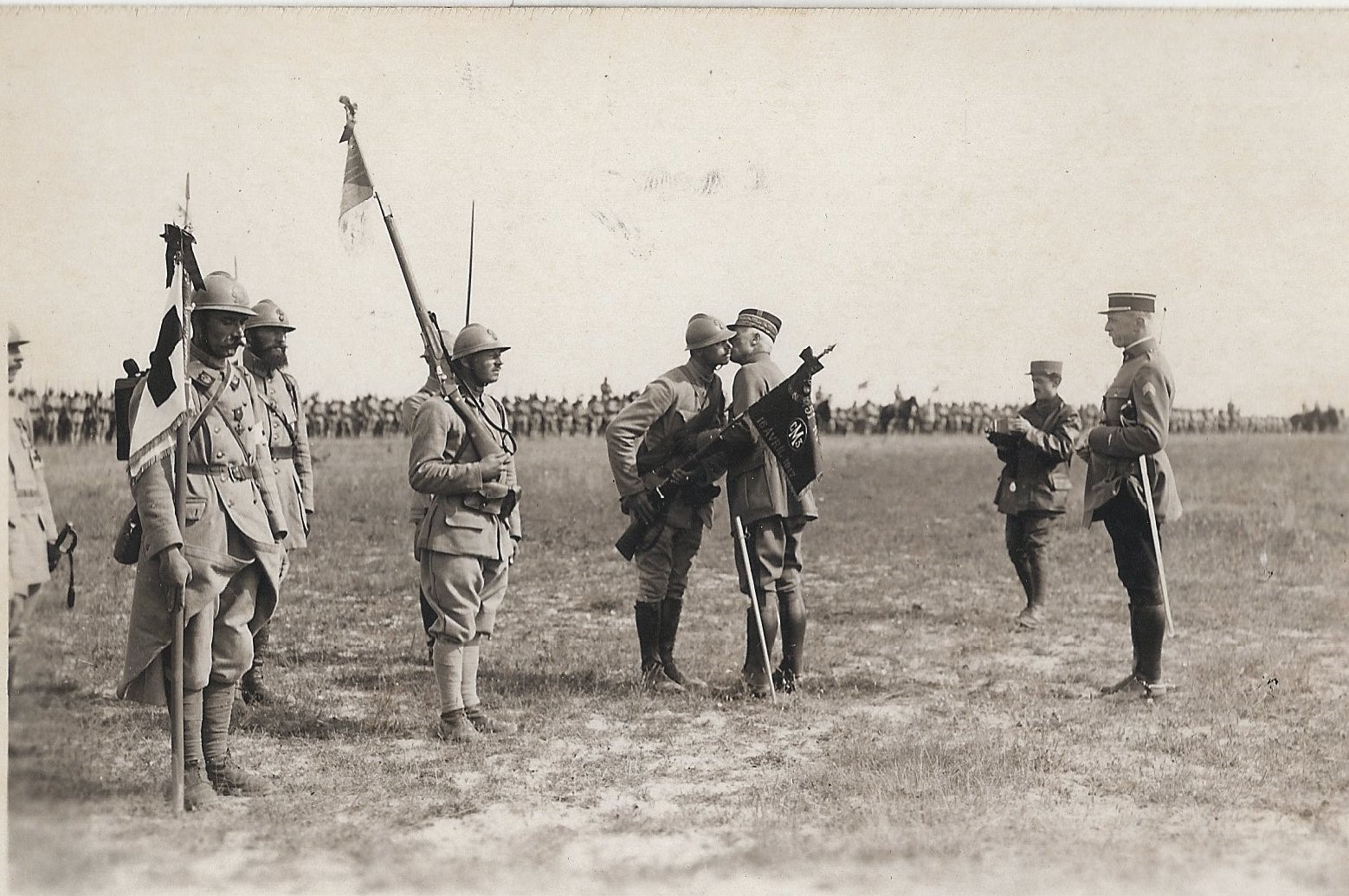
The fanion of 3 MG Co (3CM), carried by Capt. Gely, being decorated with the Crois de Guerre, 28 June 1917. Capt. Wébanck stands in the rear rank on the left.
29 June - 3 July: Instruction resumes, principally on the work of specialists. On 2 July, maneuver of cadres (officers) for the entire division in anticipation of a division maneuver, which will take place the next day. On 3 July, division maneuvers are conducted, taking over two fortified positions. Depart from billets at 1530 hrs. After the maneuver, the regiment eats breakfast at the Ferme Valmont (adjoining zone to Camp de Mailly) and returns to billets at 1600 hrs.
4 July: the 151 is alerted that it will be setting off the next day to parts unknown. Preparations are made for the departure.
5 July: the regiment boards trucks and is transported to the Bar-le-Duc region. It is now clear to the men that they are heading toward Verdun. The 1st and 2nd Bats. (along with the staff and the CHR) arrive at Laimont, the 3rd Bat. and Neuville-sur-Orne.
6 July: Lieut. Colonel Moisson is promoted to Colonel.
7-11 July: instruction resumes, particularly the work of specialists.
12 July: specialist instruction continues. As the national holiday of the 14th of July approached, orders went out to regimental commanders instructing them to select a platoon-size party of their men to act as a delegate party for the unit at that year’s Bastille Day march in Paris. The recently promoted Captain Bourgoin, who’d recovered from the jaw injury he received at the Somme the previous fall, was chosen to lead it, along with Lieutenant Coureaux and Sous-Lieut. Baillat (color-bearer). L’Huillier (now promoted to Aspirant) had also been picked, as did the stretcher-bearer, Henon, along with a body of 35 other NCOs and men. On 12 July, the party embarks at Revigny headed for Paris in order to represent the regiment at the 14 July parade.
Photo taken by André L'Huillier of the delegate party aboard its train on 16 July 1917 at Rosny-sous-Bois.
13 July: Transfers: Médecin-aide Major (2 cl.) Aubry is assigned to the 151, coming from the 6th region. Médecin-aide Major Colson passes to the 6th region.
14 July: Rest in the billets in the morning. In the evening, regimental competition between all specialists in celebration of the national holiday. Over in Paris, the delegate party marched out from its billets at Fort de Vincennes to the faubourg Saint Antoine, where it formed up on the Cours de Vincennes. There it was reviewed by political leaders before marching to the Place de la Nation. All agreed it was a thrilling event that made a powerful impression upon them, as they paraded down the Grands Boulevards of Paris in dense marching columns, cheered on by enthusiastic crowds of civilians throwing flowers. It was a welcome, rejuvenating distraction for the forty delegates given the honor of representing the Quinze-Un. For not two days later, they were back aboard a troop train being shuttled back to the front -- back to the Furnace of Verdun.
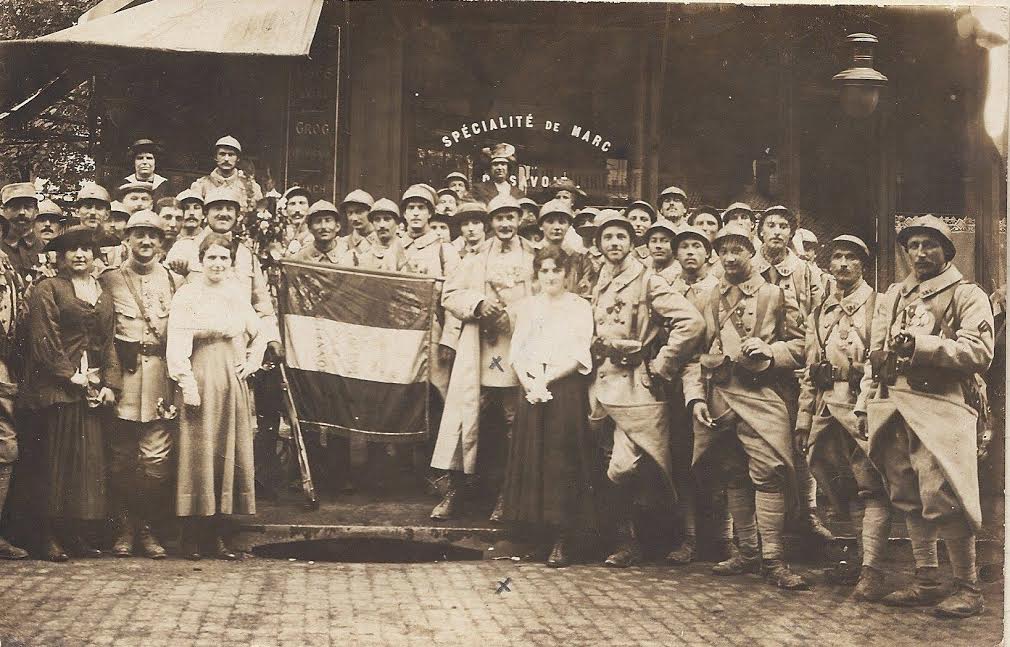
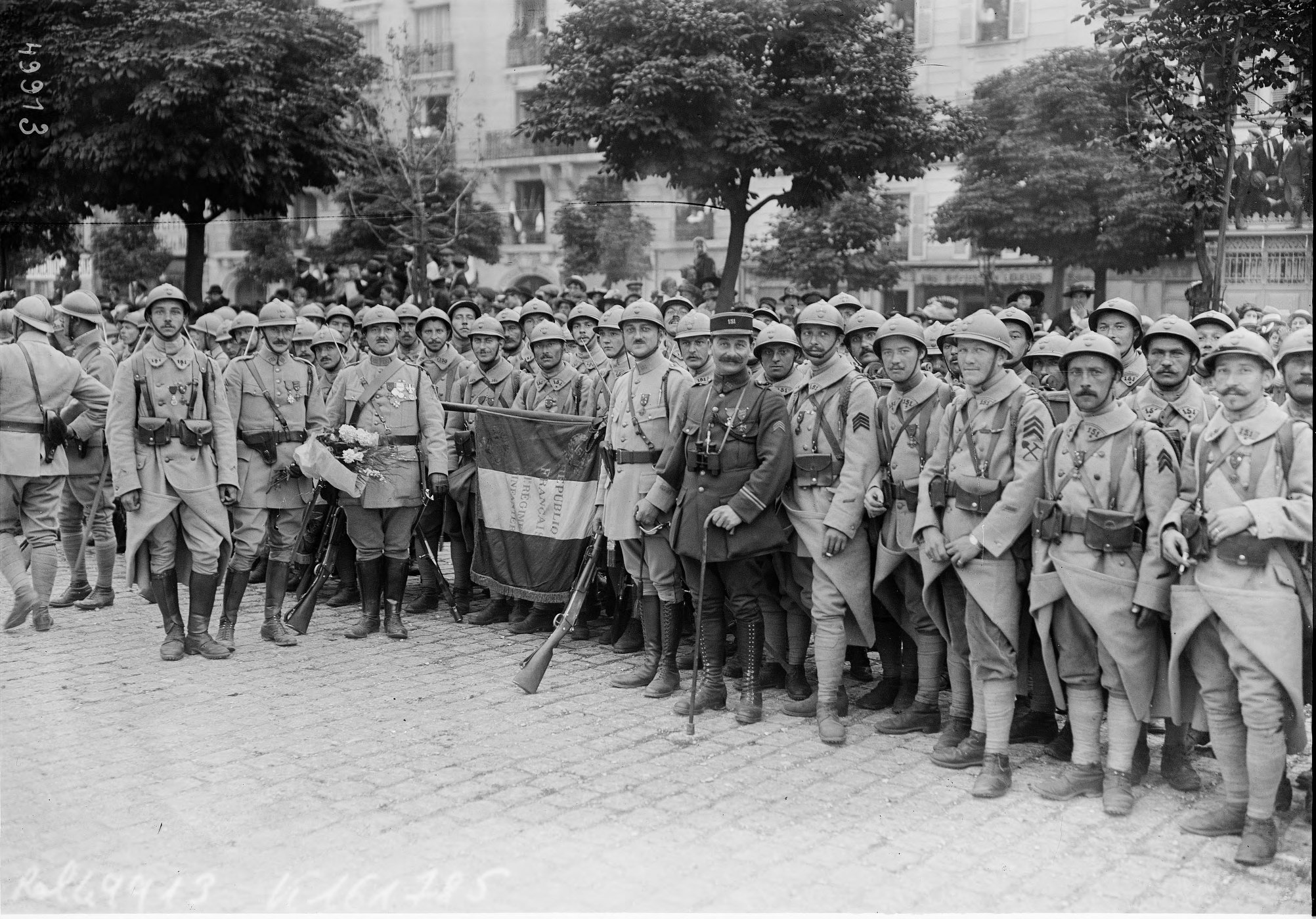
Left: The 151 delegate party for the Bastille Day celebrations formed up on the Cours de Vincennes in Paris, 14 July 1917, under the command of Captain Bourgoin (marked with an "X") detailed to march in Paris for a 14th of July parade, 14 July 1918. Right: The delegate party commanded by Captain Bourgoin, Lieutenant Courreaux, Second Lieutenant Baillat (flag-bearer)
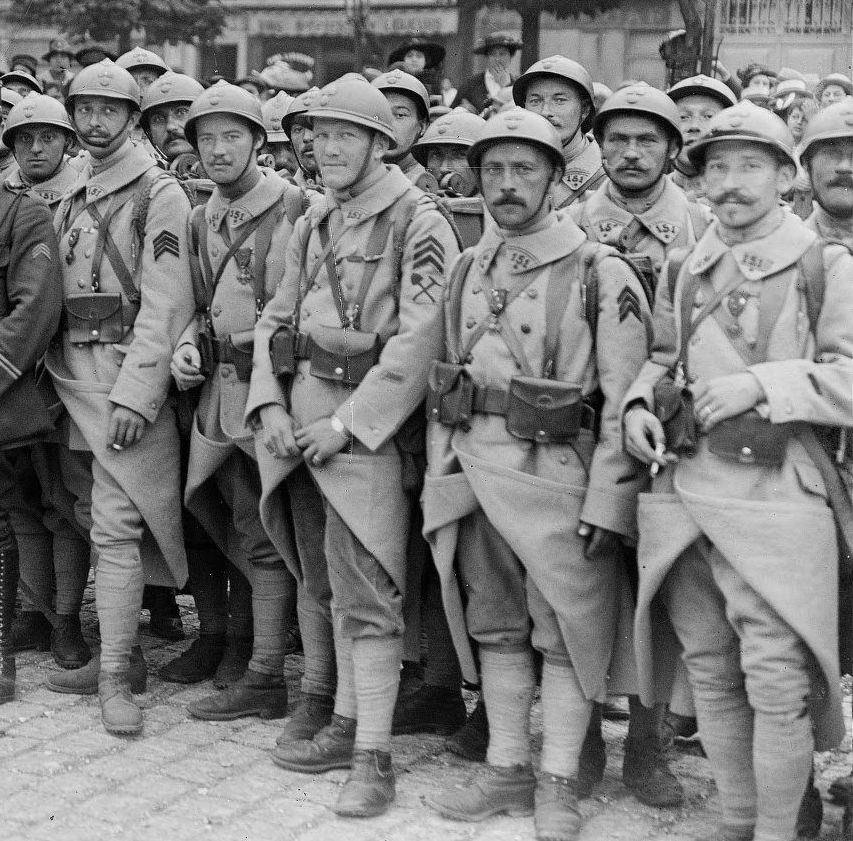
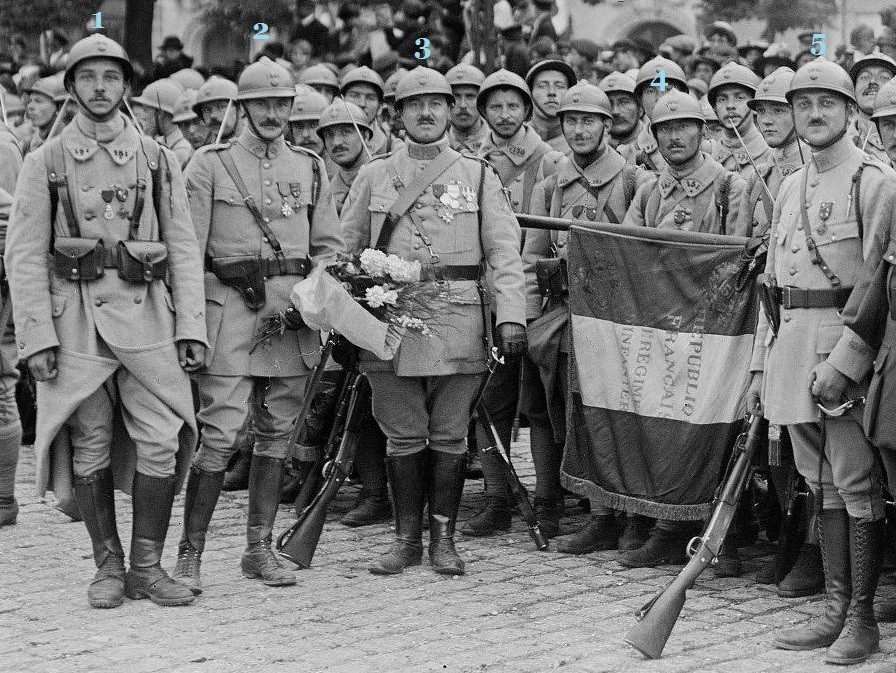
Left: Caporal Hautecoeur is on far left (2nd row), Sergent Menevielle stands just in front and beside him. Right: 1. Aspirant L'Huillier; 2. Capitaine Adj.-Major Bourgoin; 3. Sous-Lieutenant Baillat (Baya); 4. Soldat / Brancardier Charles Léon Henon (KIA 21 July 1918); 5. Lieutenant Pierre Auguste Coureaux (KIA 10 June 1918). The bouquet held by Baillat was given to the men by a young woman who had come looking for their delegate party. Later, Henon requested to place the flowers on the graves of some of his comrades.





